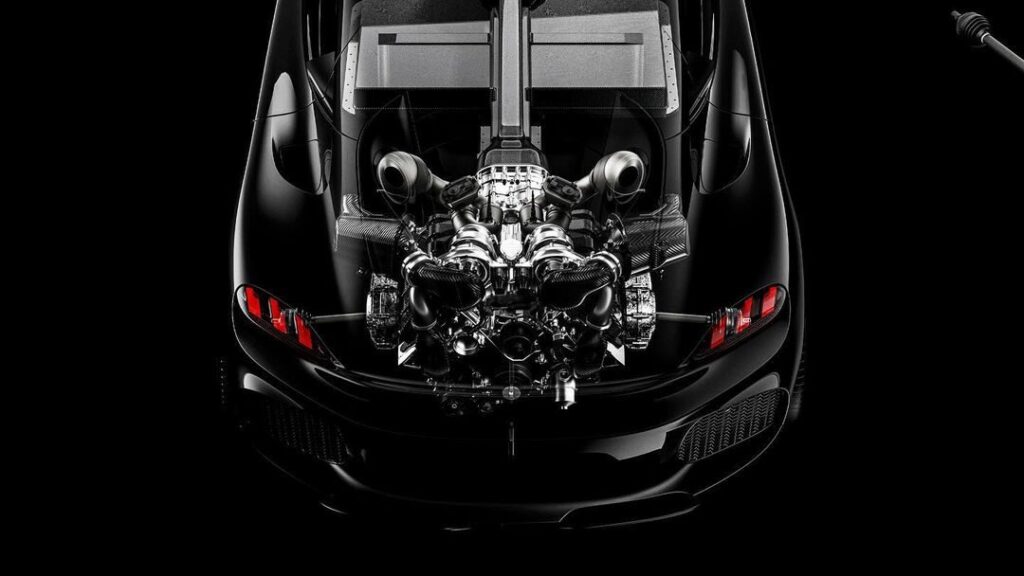Table of Contents
Introduction
The Koenigsegg Jesko is a new, highly anticipated supercar that has taken the automotive world by storm. In this blog, we will delve into the engine of the Koenigsegg Jesko, exploring its specifications and unique features. This engine is a true powerhouse, capable of delivering mind-blowing performance. From its impressive horsepower and torque figures to its clever engineering, the Koenigsegg Jesko’s engine is a marvel of automotive technology.
Specifications
Koenigsegg Jesko Specifications
| Engine Type | 5-liter twin-turbocharged V8 |
|---|---|
| Predecessor | Agera RS |
| Horsepower on Pump Gas (91 octane in the US or 95 octane in Europe) | 1280 |
| Horsepower on E85 | 1600 |
| Torque | 1500 Newton meters or 1100 pound-feet |
| Peak Torque RPM | 2700 |
| Torque Range | 1000+ Newton meters from 2700 to 6170 rpm |
| Max RPM | 8500 |
Key Points:
- The Koenigsegg Jesko is powered by a 5-liter twin-turbocharged V8 engine, similar to its predecessor, the Agera RS.
- It produces a staggering 1280 horsepower on pump gas and a mind-blowing 1600 horsepower on E85.
- In terms of torque, the Jesko can generate 1500 Newton meters or 1100 pound-feet.
- One notable aspect of the Koenigsegg Jesko’s engine is its ability to reach peak torque at just 2700 rpm, with a range of a thousand-newton meters plus of torque from 2700 to 6170 rpm.
- Thanks to a flat plane crankshaft, the engine can rev up to 8500 rpm, providing an unforgettable driving experience.
These specifications put the Koenigsegg Jesko in a league of its own, surpassing even the most powerful production engines currently available. The impressive torque curve allows for exhilarating acceleration and intense power delivery throughout the rev range.

The Future of Koenigsegg
The Koenigsegg Jesko marks the end of an era for Koenigsegg, as it is set to be the last purely internal combustion engine-powered vehicle from the brand. In the future, Koenigsegg will focus on hybrid and electric cars, much like their previous model, the Regera. However, they are bidding farewell to traditional gasoline-based engines with a bang. The Jesko’s engine is the most powerful internal combustion engine ever created by Koenigsegg and holds the title of the most powerful homologated production internal combustion engine.
Fuel Flexibility and Power Optimization
The Koenigsegg Jesko exhibits remarkable fuel flexibility. It can operate on either gasoline or E85, a feature made possible by a flex fuel sensor that identifies the type of fuel being injected into the engine.
Performance Based on Fuel Type
| Fuel Type | Horsepower |
|---|---|
| Gasoline (91 or 95 octane) | 1280 |
| E85 | 1600 |
Key Points:
- Gasoline Performance: With gasoline (91 or 95 octane), the engine produces 1280 horsepower.
- E85 Performance: However, with E85, which has a higher octane rating, the Jesko unleashes its full potential, delivering a staggering 1600 horsepower.
- Advantages of E85: Running on E85 offers several advantages in terms of power optimization:
- Advanced Timing: The higher octane rating allows for advanced timing, meaning the spark plug can fire sooner without the risk of engine knock or damage. This optimal timing results in increased power output.
- Higher Boost Levels: The higher octane rating permits running higher boost levels, further enhancing performance.
- Air-Fuel Ratio Flexibility: The flexibility in air-fuel ratio selection enables the engine to find the perfect balance for maximum power production.
These features make the Koenigsegg Jesko a powerhouse, capable of delivering exceptional performance regardless of the fuel type used.
Triple Fuel Injection
The Koenigsegg Jesko’s engine features three fuel injectors per cylinder, making it the first production car to employ this setup. This triple-fuel injection system ensures there is an ample supply of fuel for the engine’s high demands.
Fuel Injection System
| Fuel Injectors per Cylinder | 3 |
|---|---|
| Primary Fuel Injectors Location | Mounted on a traditional fuel rail within the intake runner |
| Additional Injector Location | Added to the intake plenum before each runner |
Key Points:
- Ample Fuel Supply: The triple-fuel injection system ensures there is an ample supply of fuel for the engine’s high demands.
- Precise Fuel Delivery: The additional injector provides precise fuel delivery to each cylinder.
Tumble Flow Intake Ports
Koenigsegg redesigned the cylinder head to incorporate tumble flow intake ports to ensure optimal performance in all operating conditions and comply with emission regulations.
Key Points:
- Improved Efficiency: The new design channels the air over the top of the valve, creating a tumbling airflow pattern within the combustion chamber. This turbulent airflow enhances fuel mixing, resulting in improved efficiency, especially at low RPM and low load conditions.
- Aid in Cold Starts: The tumble flow intake ports aid in cold starts by promoting better fuel and air mixing before reaching the engine.
Flat Plane Crankshaft
The Koenigsegg Jesko’s engine has switched from a cross-plane crankshaft to a flat-plane crankshaft, offering several advantages.
Key Points:
- Lighter Crankshaft: With a flat-plane crankshaft, the crankpins are rotated 180 degrees apart, resulting in a lighter crankshaft overall.
- Mitigating Vibrations: While this setup may introduce more vibrations, Koenigsegg mitigates this by utilizing active engine mounts, compensating for any potential driver discomfort.
- Higher Rev: The flat-plane crankshaft enables the Jesko’s engine to rev higher, increasing the redline from 8250 to 8500 rpm.

Unique Turbocharging System
The Koenigsegg Jesko, with an engine producing over 1600 horsepower, requires a robust turbocharging system.
Turbocharging System Details
| Engine Horsepower | Over 1600 |
|---|---|
| Turbos per Cylinder Bank | 2 |
| Air Compressor | Electric |
| Air Storage | Carbon Fiber Tank |
Key Points:
- Turbo Setup: The engine features two turbos per cylinder bank to deliver the necessary boost. However, this setup presents a challenge of high boost thresholds and turbo lag.
- Innovative Solution: To overcome this, Koenigsegg employs an innovative solution inspired by Volvo’s diesel engine technology. The Jesko incorporates an electric air compressor that pressurizes air and stores it in a carbon fiber tank.
- Eliminating Turbo Lag: When the engine needs instant power at low RPM, the compressed air is released into the exhaust, spooling up the turbochargers quickly and eliminating turbo lag.
- Improved Throttle Response: This system not only improves throttle response but also aids in cold starts by injecting air into the exhaust, helping to heat up the catalytic converter faster.
Pressure Sensors for Optimal Performance
Koenigsegg takes engine performance optimization to the next level by implementing pressure sensors in the Jesko.
Pressure Sensor Details
| First Production Vehicle with Pressure Sensors | Jesko |
|---|---|
| Pressure Measurement | Inside the cylinder during the power stroke |
| Data Usage | Fed to the engine control unit (ECU) for spark timing adjustment |
Key Points:
- Pressure Sensors: The Jesko is the first production vehicle to feature pressure sensors, which measure the pressure inside the cylinder during the power stroke.
- Optimal Peak Pressure Timing: This data is fed to the engine control unit (ECU), allowing it to adjust the spark timing for optimal peak pressure timing.
- Maximized Efficiency and Power Output: By fine-tuning the spark timing based on real-time pressure measurements, Koenigsegg maximizes both efficiency and power output.
- Improved Engine Performance: This technology ensures that peak pressure occurs precisely when it should, resulting in improved engine performance.
Conclusion
The Koenigsegg Jesko’s engine is a testament to the brand’s commitment to pushing the boundaries of automotive engineering. With its monstrous power output, fuel flexibility, unique features such as triple fuel injection and tumble flow intake ports, and innovative solutions like the carbon fiber tank and pressure sensors, the Koenigsegg Jesko’s engine stands out as a true marvel of modern engineering. As the automotive industry transitions towards hybrid and electric powertrains, the Jesko marks the end of an era for Koenigsegg, leaving behind a legacy of breathtaking performance and engineering excellence.
- Unveiling the Future: Lakshya Automotive’s Porsche Taycan Turbo GT3RS Concept
- Your Go-To Solution for a Smooth 3D Modeling Experience
- 5 Reasons Why Toyota SUVs Are the Most Reliable Vehicles on the Market
- Investing in Ferrari? A Historical Perspective
- Investing in Li Auto? A Historical Perspective
FAQs
Q: How many Koenigsegg Jesko were made?
A: Only 125 Koenigsegg Jesko were produced.
Q: How fast is the Koenigsegg Jesko?
A: The Koenigsegg Jesko has a top speed of 300 mph (482 km/h).
Q: How much is a Koenigsegg Jesko?
A: The starting price for a Koenigsegg Jesko is around $3 million USD.
Q: How fast is the Koenigsegg Jesko Absolut?
A: The Koenigsegg Jesko Absolut has a top speed of over 330 mph (531 km/h), making it one of the fastest cars in the world.
Q: How can I get the Koenigsegg Jesko in Forza Horizon 5?
A: The Koenigsegg Jesko can be obtained in Forza Horizon 5 by either purchasing it from the Autoshow or by completing certain events and challenges.
Q: How many Koenigsegg Jesko Absolut were made?
A: Only 125 Koenigsegg Jesko Absolut were produced, the same as the regular Jesko model.
Q: How fast is a Koenigsegg Jesko?
A: The top speed of a Koenigsegg Jesko depends on the model, with the regular Jesko reaching 300 mph and the Absolut reaching over 330 mph.
Q: How much does a Koenigsegg Jesko cost?
A: The price of a Koenigsegg Jesko can vary depending on the model and customization options, but it typically starts at around $3 million USD.
Q: How fast does the Koenigsegg Jesko go?
A: The top speed of the Koenigsegg Jesko depends on the model, with the regular Jesko reaching 300 mph and the Absolut reaching over 330 mph.
Q: What engine does the Koenigsegg Jesko have?
A: The Koenigsegg Jesko has a 5.0-liter twin-turbo V8 engine that produces up to 1600 horsepower, making it one of the most powerful production cars in the world.